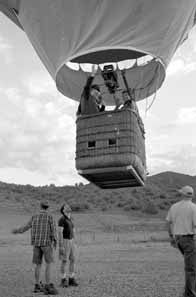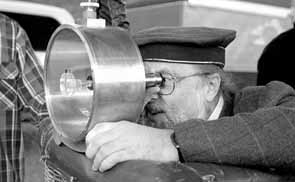 |
|
Balloon Flight Launches Cosmic Ray Education Project by Mike Perricone
"The view is spectacular," said University of Washington physicist Jeff Wilkes, leaning over the side of the wicker basket dangling from the rising rainbow-hued hot-air balloon. "The winds are at a very low level, and we've drifted only a few hundred yards from where we took off. I can see evidence of snow on the mountains, the last snow of the season. I can see a herd of horses below, but they're paying us no attention whatsoever."
A small band of early-rising witnesses, however, was paying close attention to the flight of the balloon, and to the voice of Wilkes relayed by two-way radio to University of Nebraska physicist Greg Snow, staffing the ground station this dawning Sunday, July 8. Wry comments aside, Wilkes fitted his role as early cosmic ray explorer Victor Hess: he wore the peaked cap of a civil servant in the German Empire, circa 1912, along with a neatly-trimmed beard and somewhat baggy (but surprisingly trendy) three-piece, three-button windowpane plaid suit borrowed from the University of Washington drama department.
German physicist Theodore Wulf developed the electroscope to study radiation emanating from the earth, but doubted its reliability when his measurements atop the Eiffel Tower (a height of 300 meters) were higher than at ground level. He had expected them to be lower, diminishing with distance from the earth source. Hess, studying at the Radium Institute in Vienna, decided to take the experiment a step furtherˇand a few thousand meters higher.
First, Hess determined that ground radiation would dissipate at about 500 meters of altitude. Then, in 10 balloon ascents from 1911 to 1913, he found that radiation first decreased with height, as predicted, but then increased rapidly with altitude to a level many times greater than at the earth's surface. He concluded that "a radiation of very high penetrating power enters our atmosphere from above." Hess also saw that ionization did not decrease on his flight during a solar eclipse on April 12, 1912; he concluded the sun could not be the main source of the radiation. His work won the Nobel Prize in 1936.
Wilkes and Snow are aiming for a different prize: inspiring young minds. Their re-enactment of the Hess discovery inaugurated a week-long training workshop for SALTAˇthe Snowmass Area Large-scale Time-coincidence Array, a project to set up a cosmic ray detector network in collaboration with four secondary schools in and around Colorado's Roaring Fork Valley. Using detector equipment donated by NALTA (North American Large-area Time-coincidence Arrays), the Roaring Fork Valley schools will join a network of high school and college teams extending to Canada, California, Washington State, Nebraska and Illinois, all doing "real" physics, with real data.
"The equipment is from a cosmic ray experiment called CASA (Chicago Air Shower Array), which ran for almost nine years and finished taking data in 1998," said Snow, who co-chairs SALTA with Wilkes. "The spokesperson for that experiment was James Cronin, who won the Nobel Prize for Physics in 1980."
"When I took physics as a senior in high school," she recalled, "I had an excellent teacher and I was hooked on studying physics. Getting kids excited about the cosmic ray network in high schools is very important. And we need to encourage more women to study physics."
Zorn read off the Geiger counter data during the flight, and Snow plotted the points at the ground station. The data was consistent with a Saturday morning "dry run," and with the Hess findings of early in the century. Gorrell brought the balloon down with no more than the normal allotment of bumps. "The procedure for landing," Wilkes said, "is to bend your knees and don't get out of the basket until you're told."
Traditionally, champagne is served after a successful balloon trip. Gorrell produced a wicker picnic basket from the back of the "chase vehicle," driven to the landing site to retrieve the deflated balloon. Gorrell popped the cork with a flair. The returning aerialists toasted and celebrated in the warm, golden morning. Adding their own cosmic ray measurement, the champagne glasses sparkled in the sunshine. |
| last modified 8/8/2001 by C. Hebert email Fermilab |
FRLsDFx9eyfrPXgV
 Snowmass, Colorado --The sun rose slowly and blindingly above jagged and sharp-shadowed Rocky Mountain peaks. The airborne explorers loosed their tethers and slipped upward into a thin blue sky, passing feathery clouds, plotting to measure emanations from their blazing home star and from countless stars beyond.
Snowmass, Colorado --The sun rose slowly and blindingly above jagged and sharp-shadowed Rocky Mountain peaks. The airborne explorers loosed their tethers and slipped upward into a thin blue sky, passing feathery clouds, plotting to measure emanations from their blazing home star and from countless stars beyond.
 Nearly 90 years earlier, Hess led a similar expedition into the skies above Austria. His instrumentation: a Wulf Electroscope, state-of-the-art in its day, now commonly used for high school physics experiments. In its brass case, the electroscope carries two charged strips of gold leaf, which move apart when struck by charged particles. With the electroscope, Hess entered a new realm of physics: he demonstrated the existence of cosmic raysˇelectrons and atomic nuclei, generally hydrogenˇoriginating in outer space and striking the earth from all directions.
Nearly 90 years earlier, Hess led a similar expedition into the skies above Austria. His instrumentation: a Wulf Electroscope, state-of-the-art in its day, now commonly used for high school physics experiments. In its brass case, the electroscope carries two charged strips of gold leaf, which move apart when struck by charged particles. With the electroscope, Hess entered a new realm of physics: he demonstrated the existence of cosmic raysˇelectrons and atomic nuclei, generally hydrogenˇoriginating in outer space and striking the earth from all directions.
 The SALTA balloon carried aloft two modern Geiger counters to count cosmic ray interactions; a seasoned pilot, Fred Gorrell, head of the Unicorn Balloon Company, whose efforts produced a company-record altitude of more than 13,000 feet; journalist Dave Gordon of the Snowmass Village Sun; and Washington graduate student Heather Zorn, who represented 21st century physics in contrast to Wilkes/Hessˇyoung, female, t-shirt and jeans.
The SALTA balloon carried aloft two modern Geiger counters to count cosmic ray interactions; a seasoned pilot, Fred Gorrell, head of the Unicorn Balloon Company, whose efforts produced a company-record altitude of more than 13,000 feet; journalist Dave Gordon of the Snowmass Village Sun; and Washington graduate student Heather Zorn, who represented 21st century physics in contrast to Wilkes/Hessˇyoung, female, t-shirt and jeans.